In Between Homage and Parody: On Relationships Between the Practices of Bahman Mohassess and Marino Marini
Mohammadreza Mirzaei Mohammadreza Mirzaei Marino Marini, Issue 5, May 2021https://italianmodernart.org/journal/issues/marino-marini/
Bahman Mohassess (1931–2010) is from the generation of Iranian artists who traveled to Italy in the 1950s to study at Italian academies. Mohassess spent time in the Accademia di Belle Arti in Rome, and after returning to Iran in the 1960s, he played a prominent role in the new Iranian art scene. Although he was not Marino Marini’s pupil, Mohassess’s practice demonstrates a special relationship with Marini’s art. In this essay, Mohassess’s artistic strategies are examined in the context of Iranian art in the 1960s and in terms of Marino Marini’s practice. Marini’s dialectical approach creates a route for Mohassess to problematize the descriptive qualities of figurative painting, which results in the confrontation of Mohassess with currents of abstract painting in Iran and their socio-political implications.
Bahman Mohassess (1931–2010) was among the generation of Iranian artists who traveled to Italy in the 1950s to study at Italian academies. This path was first opened up by Marcos Grigorian and continued by several other artists essential to the formation of modern Iranian art in the 1960s, including Mohsen Vaziri Moghadam, Parviz Tanavoli, Behjat Sadr, Manouchehr Sheibani, Mansoureh Hosseini, Sirus Ghaemmaghami, Setrak Nazarian, Alfonso Avanessian, and Vazgen Minasyan. For these artists, Italy was not only the birthplace of the Renaissance,1 it was also a relatively low-cost destination and one that would afford them an intimate look at the latest trends in modernism. Mohassess spent time in the Accademia di Belle Arti in Rome under the supervision of Italian artist Ferruccio Ferrazzi.2 After returning to Iran in the 1960s, he played a prominent role in the new Iranian art scene, which was trying to come to terms with “modernism.” The artistic developments of the period were intensified by artists’ return to Iran and further spurred by the various cultural programs of Mohammad Reza Shah’s regime, such as the Tehran Biennial, which was started in 1958 and ran for five editions, until 1966.
This biennial provides us a proper context for the scheme of modern Iranian art. As Grigorian, the director of the biennial and a graduate of the Accademia di Belle Arti in Rome, wrote in the first catalogue: “Iranians have not had an appropriate opportunity to have close contact with ‘modern’ art so far. Now we must bring people closer to art, to understand it as a reflection of their emotions and thoughts, and this becomes possible only if we hold many national exhibitions of modern art.”3 One of the primary purposes of this biennial was to clear the art scene from traditionalism4 in order to promote art that was both “modern” and “national.” However, in the texts published in the first biennial’s catalogue, there is no explicit definition of modernism. It seems the modern was not necessarily related to the “present” moment in time. As Grigorian stated, “The step we are taking now should have been taken fifty years ago. […] Now it is our responsibility to traverse this fifty years difference faster and in a more diligent manner.”5 These years and these artistic trends, then, were not necessarily defined in terms of chronological time; these fifty years of change were to be experienced much faster.
Following the invitation from Grigorian to “hold many national exhibitions of modern art,” the Iranian art scene witnessed various solutions to what could be termed “modern” or “Iranian” in the 1960s. In this scenario, Bahman Mohassess seemed to be a “misfit”:6 a painter who, after experimenting with abstraction (these works were shown at the Tehran Biennial in 1961 and 1963, as well as at the 1956 Venice Biennale), was refusing to continue making gestural paintings. Nor did he show any interest in paintings referencing Iranian history like those that his contemporaries in the Saqqakhaneh school were creating.
In this essay, contrary to the claim in Iranian modern art scholarship that Mohassess cannot be recognized as related to this period, I will examine Mohassess’s artistic strategies in terms of Marino Marini’s practice. Mohassess demonstrated interest in Marini implicitly and explicitly, without any hint of inferiority. As I will discuss, both artists disobeyed the rules of the grand narratives of postwar painting in Iran and Italy that involved the different potentialities of gestural painting. As discussed in Jean-Francois Lyotard’s The Postmodern Condition: A Report on Knowledge (1979), different discourses are structured by different rules, or “language games.”7 These rules create the status of knowledge in different societies, and consequently they define how identity and self-image are represented through such knowledge. Mohassess seems to have challenged such rules in the postwar Iranian art scene by not obeying the proposed conventions, and instead representing different language games. His strategy was to challenge the reduction of painting to a single system aimed to make the art object “readable” – in line with the aims of the Shah’s regime or Western institutions. In this paper, Mohassess’s approach is analyzed by studying the relationships between his work and the practice of Marini, whose dialectical approach created a route for problematizing the descriptive qualities of figurative painting.
Marino Marini and Iranian Art
Marini was a reference point for Iranian artists studying in Italy, and his name can be found in the writings of critics such as Karim Emami.8 He was important enough in Iran that in 1970 the Iranian magazine Haft Honar published a critical text on his work, illustrated with several images (figure 1). The writer of this article, Reza Oliaei (or Reza Olia), had studied at the Accademia di Belle Arti in Rome under Pericle Fazzini and Renato Guttuso and had gone on to teach sculpture at the University of Tehran.9 Olia’s article presents Marini’s biography introduces him as an artist experimenting with humans and nature beyond their outward forms to express his subjectivity, expression, and poetic imagination.10
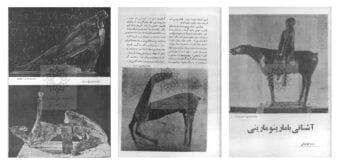
In addition to this critical attention, Iranian artists such as Parviz Tanavoli and Sirus Ghaemmaghami were among Marini’s students at the Accademia di Brera in Milan. This connection has led scholars to limit Marini’s influence to the practices of such artists. This is especially true of Tanavoli, whose success on the international market drew greater critical and scholarly attention to his work.
The bond between Tanavoli and Marini, and to some extent Emilio Greco, seems to have been relevant in the initial years of Tanavoli’s practice. He, indeed, learned to work with the potentialities of the past and to study the archaic languages of sculpture. However, the lack of equivalent materials in the history of Persian sculpture pushed Tanavoli to rely on myths or narrations. Tanavoli’s interest in the character of Farhad, a semifictional/mythical character who is believed to be the sculptor of certain pieces of the Sassanid period in Iran, always pushed him to hint at the realities outside of his sculptures. This is quite unlike Marini, who deprived his subjects of narratives and problematized the historical contexts of his references.
Tanavoli seems to have taken the idea of working in a series from Marini. His reclining man, which becomes a repetitive theme, and even his animals are instances of the influence of his Italian master. However, soon these series morphed from a modernist determination to a study of forms (as per Marini or Giorgio Morandi) to a mass-produced aesthetic inspired by American Pop artists. Tanavoli himself stated that, from what he had seen of American artists during his stay in Milan, London, and at the Venice Biennale, he found “the art of America progressive and exciting” and he dreamed of visiting the country.11 This elucidates the relationships between his most famous works, his sculptures of the word Heech (meaning “nothing” in Persian), and paintings by Robert Rauschenberg or Andy Warhol. He believed those American artists wanted to show nothing, just as he did, but in different ways. According to his autobiography, his dream was to sell Heech products in supermarkets, making a factory of Heech production to export to the world.12 Thus, Tanavoli’s Italian phase – and his bond to Marini – form only a brief spell in his career, as he exaggeratedly pivoted his strategies toward the American language of art-making.
Bahman Mohassess and Marino Marini
Although he was not Marini’s pupil, Mohassess’s practice demonstrates a special relationship with Marini’s art. We should note that Mohassess’s painting and sculpture have always been in dialogue with different artists he seems to have admired, from Pablo Picasso to Georges Braque and Giacomo Manzù. However, as Iranian critics have noted, Marini appears to have been particularly important to Mohassess.13 One can recognize their closeness in the thematic similarities of their works, their painterly language, and the odd historical references. For instance, Mohassess made an Etruscan Cista in 1975 (figure 2), a very unusual object for an Iranian artist to make, and one that directs us to Marini’s interest in Etruscan art.
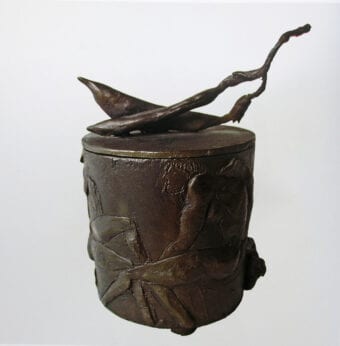
While Mohassess did not directly comment on Marini, he was interested enough that he prefaced one of his two monographs, Bahman Mohassess. Scultura, Pittura, Grafica, Teatro (Bahman Mohassess: Sculpture, painting, graphics, theater, 2007), with a quote by the Italian sculptor: “It was built, destroyed, and it remained a sad song on the world.”14 Marini had written this under the equestrian bronze he built for The Hague, a monument to memorialize the victims of World War II. It is his biggest work, at six meters in height. This quote is used again in a work about Mohassess, as an epigraph to one of the sections of a documentary film about the last days of his life, Fifi Howls From Happiness (2013, dir. Mitra Farahani), where he talks about the destruction of his own works.
The bond between Marini and Mohassess, however, was not yet considered by critics during the 1960s. When Mohassess held his first exhibition in Iran Gallery in 1965, Ruyin Pakbaz and Mohammadreza Jodat, the directors of the gallery, discussed the exhibition, criticizing different aspects of his practice. They called him somebody who knew nothing about his environment or his people. They also labeled his work a useless return to figurative painting, terming it a depiction of a metamorphized human being that did not even engage decrepit Western intellectuals anymore. Jodat concluded that Mohassess was irrelevant to contemporary painting: “This exhibition was the end of Mohassess.”15 It was a return to figurative painting, and one which did not make sense in Iran or the West, from their point of view. Although Iran Gallery was founded to have a critical approach to mainstream Iranian art, their critique of Mohassess relied on the same two qualities emphasized in Grigorian’s Tehran Biennial catalogue: nationalism and modernism. Of course, their claims can be challenged, and in particular they reveal an unfamiliarity with Italian artists such as Marini, who came to prominence after World War I but were still active in the postwar period.
In a painting (figure 3) in the very same Iran Gallery exhibition, Mohassess recreated one of Marini’s favorite subjects, the rider. Marini had been dealing with this subject ever since he exhibited his first rider in 1936, at the Venice Biennale. Riders were historically monumental and associated with power. This figure was, at first, more of a pretext for Marini’s formal research into pure plastic form, even as the sculpture maintained the iconographic qualities of rider and horse. After World War II, Marini turned his interest away from the female nude as riders became central in his practice. He gradually came up with new formal solutions for this theme. The figures became harder to recognize, due to being in motion or mixed with the horse itself, which bowed down to the ground or showed disobedience in its effort to unsaddle the rider. All this problematized the traditional iconographic qualities of the subject and turned these elements into intensified expressionistic forms. Mohassess’s approach to Marini’s subject disempowered not only the rider, but also the horse. In his version, masks were placed on the face of both the rider and the horse, while the rider had his arms and legs severed. The rider seems not to possess any power, nor does the horse show any interest in disobedience.
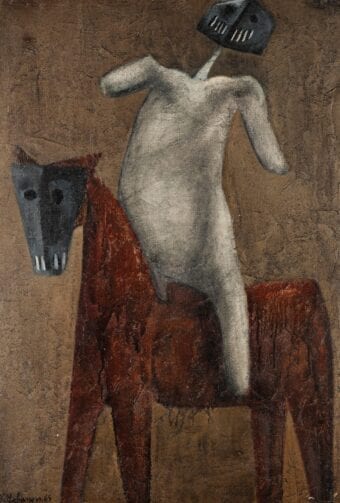
Let us compare this painting by Mohassess with Marini’s painting Invocazione (Invocation, 1955; figure 4). Both painters use a simple background, more like a texture, to avoid defining a location beyond their canvas. In both paintings, the rider’s face is not recognizable. In the case of Marini, it is simply undefined, while in the case of Mohassess, the mask hides the face. The forms of the riders’ hands are also similar, in that they are representative only to the extent that they problematize representation itself. However, by focusing on movement and emotional qualities, Marini deliberately creates a tension between abstraction and figuration. This is a distinction between the paintings. Mohassess has no interest in such tension, apparently intending to explain something with his painterly language and to keep the allegorical implications of the rider. Overall, then, despite the conceptual and structural similarities, Mohassess’s Rider seems to be different from the riders Marini made over his lifetime. Is Mohassess’s work then to be read as a parody or an homage? Is he finally praising Marini, or destroying his favorite subject?
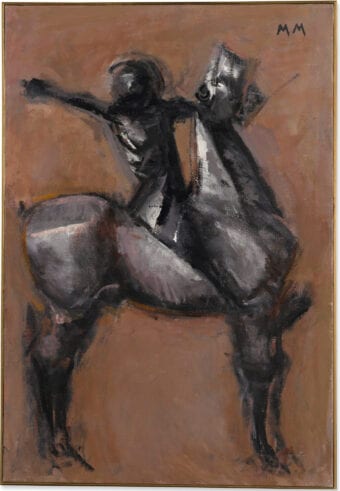
So, as is clear here, while studying and being interested in modern European traditions, Mohassess maintained a complicated relationship with them. As Enrico Crispolti wrote: “He believes in his right to participate from the inside, not from the outside.”16 Crispolti claimed that his participation was dialectical. Mohassess restored his cultural and personal identity through a critical practice toward modern European art. Perhaps such an approach can be useful in understanding Mohsassess’s interest in Marini. Marini’s works display their dialectical qualities in diverse ways, most evidently in the confrontation between the present and the past. As Flavio Fergonzi has written about Marini’s portraits with polychrome touches: “The pictorial emphases, like archeological finds (colored lips and eyes; sometimes plaster-like fields of a uniform terracotta color laid on and then scraped), distanced the sitter from the present time and put him in a timeless situation.”17 So this – the sculptural language of Marini’s work – is able to add uncertainty to its deterritorialization in time.
From the beginning of his career, and in dealing with a few fixed themes and, consequently, fixed content, Marini emphasized the language within which the themes were represented. This strategy led him to gradually weaken the allegorical qualities of his subjects. Considering Carlo Carrà’s position towards one of Marini’s riders from 1936, Fergonzi names this complexity between the meaning of the theme and its formal quality as central to Marini’s practice – “the dialectic between pure abstract forms and the meaning of that which was represented.”18 From the Miracolo (Miracle) series onwards, forms and meanings moved closer to each other in the work, becoming harder to separate. While using volume and detail for sculptural representation, his representative language was undergoing a process of radicalization, in such a way that somehow, the language itself became the subject of his work.
In the exaggerated Miracolo, while the forms still represent to some extent, the iconographic quality of the elements is weakened as their expressive aspects are enhanced. The horse, which appears to have landed on the ground, seems to be tired or injured, or perhaps it signifies that the story has reached a conclusion – the rider’s anatomy is stretched. In examples such as the 1951 Piccolo miracolo (Little miracle; figure 5), which is held at the Fondazione Marino Marini in Pistoia, the horse and the rider seem to have even become somewhat united, with the rider’s head attached to the horse’s back and the horse’s legs continuous with the rider’s legs. This can be seen as a kind of movement away from the horse as a formal element, arriving at a point where the symbol can only be expressed in such sculptural language. Marini’s next experiments, with the Guerriero (Warrior), were even more radical. In one such figure from 1958-1959 (figure 6), the dialectic between representation and abstraction reaches a point that the sculpture does not represent at all. The severe and rough texture of the body indicates that the sculptor has treated the surfaces just as before. They are still detailed, but these details are not in line with the similarities between the surfaces, volumes and constellations of meaning in the world. Marini pushes the statue out of the circle of common meanings, referents, and signifieds. It seems more like a “signifier,” more like a sound, than a “word.”
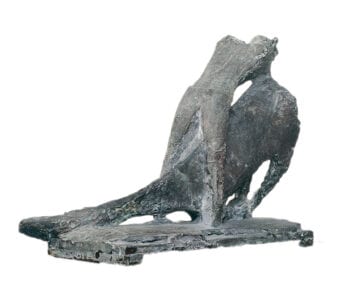
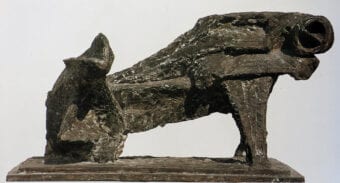
Such a retreat from representational qualities, while using figuration, is a quality that mattered to Mohassess too. In 1958, in a statement for his exhibition at the Galleria dell’ Incontro in Rome, he wrote: “In my works, we can find forms of fish, plants, birds, human beings […] but this does not imply any merely descriptive intention.”19 However, how can one create figurative paintings without descriptive intentions? Mohassess’s approach should be considered in the context of Iranian painting in the 1960s and his confrontation with the two main currents of Iranian painting during this period.
In that decade, abstraction became a significant trend in Iranian painting, among artists such as Mohsen Vaziri Moghadam and Behjat Sadr, graduates of the Accademia di Belle Arti in Rome and the Accademia di Belle Arti di Napoli in Naples who became professors at the University of Tehran. Sadr and Vaziri studied under painters including Antonio Corpora and Toti Scialoja. By emphasizing gestures and materiality, their work entered into a dialogue with the abstraction of their Italian teachers and peers, becoming unlike any forms of abstraction within the history of Persian art. Although contemporary documentation shows that the Iranian audience had little interest in this new form of abstraction,20 Sadr’s and Vaziri’s art found a sense of meaning in relation to the paradigms of Western painting.
In contrast, there was the school of Saqqakhaneh. While using Iranian elements and Islamic motifs to define itself as meaningful, these artists’ paintings remained relevant to postwar art paradigms, namely gestural painting and Pop art. For example, Charles Hossein Zenderoudi, one of the most important painters of Saqqakhaneh, began by dealing with Islamic elements, but from the mid-1960s relied more heavily on lines, designifying them and emphasizing their movement. Made using materials such as the reed pen, his works in the late 1960s are gestural and emphasized materiality, and are thus quite similar to paintings by Vaziri and Sadr.
In such a context, Mohassess’s avoidance of conforming to such paradigms remains essential to understanding his practice. After returning to Tehran from Rome in 1963, in solo exhibitions at Iran Gallery in 1965 and at Seyhoun Gallery in 1967, Mohassess made a decisive shift: he abandoned abstract painting in favor of figuration. Indeed, Mohassess appears to have made this decision quite consciously. Interviewed in 1994, he claimed that since the late 1950s he had predicted that figuration, not abstraction, would be painting’s future.21 And already in an interview with Arash magazine in 1965, he was criticizing abstract Iranian art for the incompetency of its practitioners, while also faulting Western abstraction for its commercialism.22
According to Lyotard, there are sets of rules that define the status of knowledge in different societies. These rules can legitimize or delegitimize any action by a cultural agent. However, Lyotard showed that such rules are also efficient at making each move reifying in supporting the hemogenic intentions of the system. Gestural painting was accepted as a norm in a forcibly modernized Iran. In such a situation, it could represent the modern face of the country, its intention to progress, while in terms of Saqqakhaneh, it provided somehow an exoticizing portrayal for the Western eye. Mohassess, by fragmenting those language games (or refusing to play them), resisted this artistic-cultural force and lobbied for more plurality and openness in painting, and while engaging in a direct conversation with his favorite instances of Western art, he also challenged it in an individualistic way.
Mohassess’s individualistic approach can be witnessed in his painterly language. By ignoring descriptive intentions, he focused on signifiers (lines, surfaces, chiaroscuro). However, the outcome does not necessarily relate to the task of pushing the painting toward abstraction. He made his representations more difficult to signify, pushing perhaps towards a liberation from the domination of imposed meanings. Therefore, his search for a new painterly language did not result in making painting meaningless, but instead in finding meaning. In the same exhibition where his Rider was exhibited, Bahman Mohassess’s most famous work, Fifi Howls From Happiness (1945, figure 7), was also on display. In this painting, a red creature, with a large facial cavity, is screaming in front of a simple background, resembling a poorly built mud wall. What gender is Fifi? We do not know. Who is Fifi? Why are they howling? What is the creature? How can it be defined outside the existing world of painting? Mohassess avoided falling into a merely representative language game, instead creating this impossible situation – the impossibility of complete signification while being trapped by a tendency to signify.
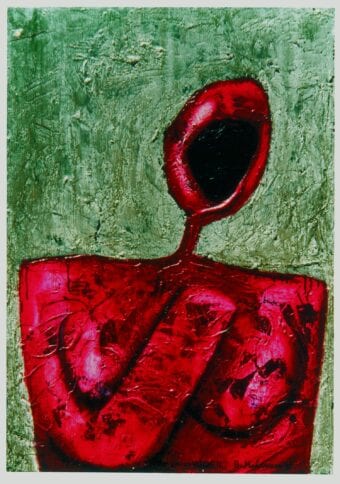
Considering such a strategy, it is interesting that Mohassess kept Western painting as one of the frequent subjects of his work. However, just like his recreation of Marini’s rider, instead of making the reference clear, he radicalized his painterly language, and made the source harder to recognize. Therefore, in his paintings, the reference is not painted to refer, but to complicate its relationship with the referent. This again demonstrates a similarity to Marini’s practice. In her study of the new formal challenges in Marini’s work in the 1950s and 1960s, Barbara Cinelli highlights the dialogue Marini created with the works of Pablo Picasso and Henry Moore. Cinelli, citing Picasso’s biographer Christian Zervos’s views towards Marini, justifies the update to the rider theme in the 1950s. Zervos believed that while Marini was a true artist, his personality was still emerging at the time, and that it needed to be polished up. Therefore Marini studied Picasso’s imaginario and used it as an opportunity to update the rider theme.23
So far, I have discussed the effects and similarities of Marini’s sculptures and Mohassess’s paintings. However, it is interesting to note that influences on Marini’s sculpture could have already found their way in through painting itself, and Picasso was also a favorite artist of Mohassess. In 2001, Mohassess praised Picasso in a long, passionate article titled “The Human Altamira,” which considers Picasso’s project to “deny the existing reality and create a new one.” In Picasso’s view, the “sketch becomes the alphabet, and importance is in the word that (such an alphabet) makes it.” So far, so similar to the approach of Marini and Mohassess: building a new reality with the language of the medium within which they worked.
Further, for Picasso, Mohassess wrote, “all history is present.”24 Accordingly, Picasso was in constant conversation with his favorite painters from different times and was able to appropriate or deconstruct whatever he wanted to. Again, this sounds like an aspect of Mohassess’s own practice and of course Marini’s. Much has been made of Marini’s references to various historical monuments and moments. Talking about his approach, Cinelli relates Marini’s Guerriero to Picasso’s Woman and Dog Playing, Blue Ground (1953; figure 8) with its “sharp angles intersecting the figures.”25 Picasso’s painting is, interestingly, very similar to Mohassess’s Requiem Omnibus (Death of Martin Luther King)(1958; figure 9). Two figures face each other in Mohassess’s painting: radical in appearance, with cylindrical lines and volumes that cannot be described as representational. While their compositions are very similar, in their details Mohassess made them as different as possible, it seems. The gesture and organs of the exaggerated figures could remind us of other earlier paintings by Picasso, especially the Woman sitting on the beach (1937, figure 10). Unlike Picasso, Mohassess doesn’t show any interest in depicting these figures from various points of view; however, the characters and even the location seem to be the same. In the meantime, everything can be completely different. Here, instead of a bather, we see a dying or dead body. Another figure, which seems to be female, appears to be mourning over that body. In this sense, Mohassess transforms Picasso’s paintings into a Pietà,26 now a contemporary one. By making the details so different and the references doubtful, Mohassess laid claim to his own identity. Marini’s strategy, on the other hand, was to exaggerate signifiers to such a degree that they are challenging to read at all. The signifiers barely hint at any signifieds. His outcome, then, fits more neatly into the artistic label of “abstraction.”
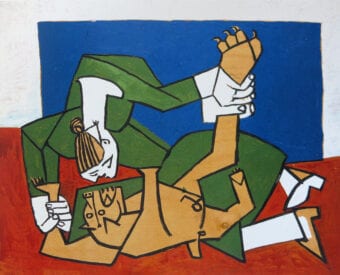
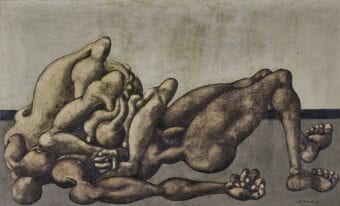
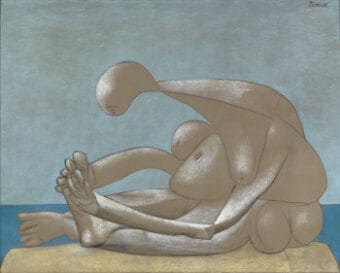
Mohassess’s dialogue with Marini did not limit itself to a painting-sculpture relationship. Mohassess left Iran in 1968, going back to Rome, where he started to make sculpture. As he said, his sculpting took an anti-sculpture approach. Crispolti27 related this to what Arturo Martini clarified in in his text La scultura lingua morta (Sculpture, a dead language, 1945),28 which addresses “the autonomous expressive capacities, and limitations, of the sculpted form.”29 So, according to Martini, limited by its literalness, sculpture is destined to fail in transforming inert matter into poetic metaphor.
Martini’s solution was to escape human forms. However, Mohassess’s sculptures, in this new phase of his practice, still embraced humans. Just like his paintings, these sculptures seem to make connections with different moments in history, from Centauro in the Parthenon to an Etruscan Cista (figure 2). He reconstructed these subjects and became interested in the way they were built as much as in the impact of their making on the inherent qualities of the subject. Again, this was similar to his treatment of the subjects he took from other painters.
Certain Mohassess’s sculptures seem to make direct reference to Marini’s, for instance Mohasess’s Horse (figure 11), made in 1971, which Bavand Behpour has compared to Marini’s 1950 Piccolo Cavallo (Little Horse) (figure 12).30 While Behpour recognizes the reference, he bases his argument on the differences between the horses. Marini’s phallic horse does not bow its head; it stands stubbornly. Mohassess’s horse is broken and crushed. Behpour states that, unlike a horse that never falls to its knees (and even sleeps standing), this horse came crushed out of Mohassess’s hand. Like Mohassess’s Rider, this horse doesn’t look like a horse by Marini. Is it an homage to Marini? Or is it a parody?
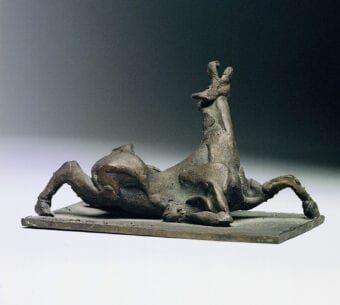
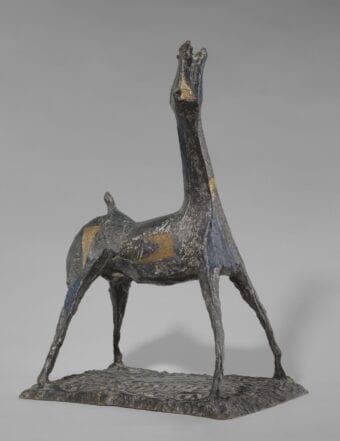
Also relevant here is Mohassess’s sculpture Bather (figure 13), which resembles a sculpture by Marini of the same subject (1934; figure 14). Marini’s sculpture represents his early interests in studying classical figures, and is a naturalistic representation of the female figure. He dedicated a good amount of detail to the figure’s face, hair, and body. Mohassess used the same material – bronze – but changed – once again – the details as much as he could. The head of the figure appears crushed, and while the breasts hint at the figure’s gender, the legs and hands lack the specificity of Marini’s bather. She is lying on a board, just like Marini’s figure. Their compositions are not dissimilar, but the individual differences in Mohassess’s are evident.
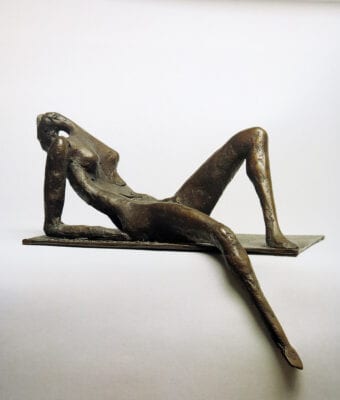
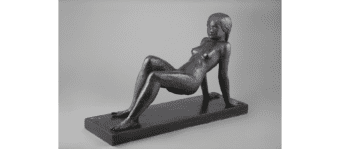
In studying Mohassess’s work, we see a specific interest in Marini, and this has not gone unrecognized by Iranian critics. This interest was related to Marini’s dialectical approach to time and the sculptural qualities of figuration versus abstraction. While Mohassess shared also thematic interests with Marini, his work reflects his nonconformity even with relation to Marini himself. Mohassess opposed the totalities of his references, which can be read as a push against totalitarianism itself – its insistence that everyone be the same for purposes of control. In the context of Iranian painting in the 1960s, with artists’ new, powerful conformism to the postwar paradigms of abstraction, Mohassess demonstrated his own rebellion through the painterly language he executed. Such resistance makes Mohassess an aberration within the narratives of Iranian modernism, an intriguing but unique, individualistic outsider who bucked the trends of the time. The relationships seen between the practices of Marini and Mohassess not only open up new dimensions for exploring the relationships between Italian and Iranian postwar modernism, but also offer suggestions for art that wishes to resist the hegemonic homogeneity of meanings and categories within representation.
Bibliography
“Gofto Shenūdī bā Bahman-e Mohassess Naqāsh.” Arash Magazine, no. 9 (November 1965): 91–106.
“Namāyeshgāh-e Naqāshī-yie Mohassess.” In Iran Gallery Annual Book, 36–41. Tehran: Iran Gallery, 1965.
“Olia Reza.” Museo dei Bozzetti. Accessed December 29, 2020. http://www.museodeibozzetti.it/assets/files/mdb/collezione/artisti/s000400.php.
“Parvandeh-ye Bahman-e Mohassess.” Text and Image. Accessed January 29, 2021. http://reviews.behpoor.com/?p=7560.
Afsarian, Iman. “Biyenāl-e Qodrat: Meydān-e Reqābat-e Honarmandān-e Naqāsh.” Jāme-e Shenāsi-e Honar va Adabiāt, no. 2 (Fall 2009): 171–95.
Braun, Emily. “Bodies from the Crypt and Other Tales of Italian Sculpture between the Wars.” In Chaos and Classicism: Art in France, Italy, and Germany, 1918–1936, edited by Kenneth E. Silver, 145–57. New York: Solomon R. Guggenheim Museum, 2010. Exhibition catalogue.
Cinelli, Barbara. “New formal challenges after the Second World War.” In Marino Marini Visual Passions, edited by Barbara Cinelli and Flavio Fergonzi, 190–207. Milan: Silvano Editore, 2017.
Crispolti, Enrico. “Bahman Mohassess dar jostojū-ye hovīyat-e amīqtar.” Kelk 2 (April 1990): 172–75.
Daftari, Fereshteh. “Redefining Modernism; Pluralist Art Before the 1979 Revolution.” In Iran Modern, edited by Fershteh Faftari and Layla S. Diba, 25–43. New York: Asia Society, 2013.
Emami, Karim. Gāl… Gāl.. Gālerī Morurī bar Rūyedādhā-ye Honarhā-ye Tajasomi-ye Īrān Daheh-ye 1340. Translated by Mehran Mohajer. Tehran: Nilloofar Publications, 2016.
Fergonzi, Flavio. “Before his international fame: Marino Marini’s sculpture between the 1930s and 1940s.” In Marino Marini Visual Passions, edited by Barbara Cinelli and Flavio Fergonzi, 12–39. Milan: Silvano Editore, 2017.
Galloway, David. Parviz Tanavoli: Sculptor, Writer and Collector. Tehran: Iranian Art Publishing, 2000.
Lyotard, Jean-François. The Postmodern Condition: A Report on Knowledge. Translated by Geoff Bennington and Brian Massumi. Minneapolis: University of Minnesota Press, 1984.
Mohassess, Bahman, Enrico Crispolti and A. V. Serov. Bahman Mohassess: Scultura, Pittura, Grafica, Teatro. Rome: Società Editrice Romana, 2007.
Mohassess, Bahman. “Ensān-e Āltamīrā.” Bukhara Magazine, no. 11 (March 2001): 61–76.
Oliayei, Reza. “Āshnā-yi bā Mārīno Mārīnī.” Haft Honar Magazine, no. 2 (Spring 1970): 52–55.
Tanavoli, Parviz. Atelier Kaboud. Tehran: Bon-gah Publication, 2005.
Vaziri Moghaddam, Mohsen. Yādmāndeh-hā. Tehran: Nazar Publications, 2018.
Yarshater, Ehsan and Marcos Grigorian. Introduction. The First Exhibition of the Tehran Biennial. Tehran: General Administration of Fine Arts, 1958. Exhibition catalogue.
- Some of these artists emphasized their fascination with the Renaissance. For instance, Parviz Tanavoli mentioned that he was granted a scholarship to study in Iran by Mehrdad Pahlbod, the minister of culture and the arts, to become “a minor Michelangelo” making a statue of Shah. See David Galloway, Parviz Tanavoli: Sculptor, Writer and Collector (Tehran: Iranian Art Publishing, 2000), 58. Also, Mohsen Vaziri Moghaddam recounted that he had heard about Renaissance artists such as Michelangelo, Leonardo da Vinci, and Botticelli, and he had always wished to visit their works in museums. See Mohsen Vaziri Moghaddam, Yādmāndeh-hā (Tehran: Nazar Publications, 2018), 121.
- Bahman Mohassess, Enrico Crispolti, and A.V. Serov, Bahman Mohassess: Scultura, Pittura, Grafica, Teatro (Rome: Società Editrice Romana, 2007), 222.
- Ehsan Yarshater and Marcos Grigorian, introduction to The First Exhibition of the Tehran Biennial (Tehran: General Administration of Fine Arts, 1958), 5. All translations are mine.
- Iman Afsarian, “Biyenāl-e Qodrat: Meydān-e Reqābat-e Honarmandān-e Naqāsh,” Jāme-e Shenā si–e Honar va Adabiāt, no. 2 (Fall 2009): 174.
- Yarshater and Grigorian, The First Exhibition of the Tehran Biennial, 5.
- Fereshteh Daftari described Mohassess as “a misfit in art historical narratives.” See Daftari “Redefining Modernism; Pluralist Art Before the 1979 Revolution,” in Iran Modern, ed. Fereshteh Faftari and Layla S. Diba, (New York: Asia Society, 2013), 34.
- Lyotard took this term from Ludwig Wittgenstein. See Jean-François Lyotard, The Postmodern Condition: A Report on Knowledge, trans. Geoff Bennington and Brian Massumi (Minneapolis: University of Minnesota Press, 1984).
- For instance, Emami mentions that Tanavoli was a student of Marini, “the renowned Italian sculptor,” and that this Italian education was a great gift for him. Also, in criticizing Sirus Ghaemmaghami, he says that if he didn’t show his works it was better even for Marini. Karim Emami, Gāl… Gāl.. Gālerī Morurī bar Rūyedādhā-ye Honarhā-ye Tajasomi-ye Īrān Daheh-ye 1340 (Tehran: Nilloofar Publications, 2016), 33 and 44, ebook.
- “Olia Reza,” Museo dei Bozzetti, accessed December 29, 2020, http://www.museodeibozzetti.it/assets/files/mdb/collezione/artisti/s000400.php,.
- Reza Oliayei, “Ashnaei Ba Marino Marini,” Haft Honar Magazine, no. 2 (Spring 1970): 54.
- Parviz Tanavoli, Atelier Kaboud (Tehran: Bon-gah Publication, 2005), 25.
- Ibid., 58–60.
- Iranian painter and critic Aydin Aghdashloo interviewed about Mohassess, mentioned: “This kind of surrealist approach, with the influence of Picasso in some of his paintings, with the influence of Marini and others, has finally led to a kind of painting that is Bahman Mohassess’s painting. The result is unparalleled. Not even in another place.” See “Mosāhebe bā Āydīn Āghdāshlū,” Text and Image, accessed March 16, 2020, http://reviews.behpoor.com/?page_id=6127. Also, the Iranian art writer Bavand Behpoor has noted: “Mohassess is said to have been greatly influenced by Marino Marini. It is said Marini was even Mohassess’s teacher.” See Behpoor, Text and Image, accessed March 16, 2020, http://reviews.behpoor.com/?tag=%D8%A8%D8%A7%D9%88%D9%86%D8%AF-%D8%A8%D9%87%D9%BE%D9%88%D8%B1&paged=10.
- “Si costruì, si distrusse/un canto desolato restò nel mondo.” Bahman Mohassess. Scultura, Pittura, Grafica, Teatro.
- Iran Gallery Annual Book (Tehran: Iran Gallery, 1965), 36–41.
- Enrico Crispolti, “Bahman Mohassess dar jostojū-ye hovīyat-e amīqtar,” Kelk 2 (April 1990): 173.
- Flavio Fergonzi, “Before his international fame: Marino Marini’s sculpture between the 1930s and 1940s,” in Marino Marini Visual Passions (Milan: Silvano Editore, 2017), 25.
- Ibid., 17.
- Enrico Crispolti, “Presntazioni,” in Bahman Mohassess: Scultura, Pittura, Grafica, Teatro, 7.
- For instance, in 1964, Karim Emami, a major Iranian art critic at the time, declared that “young Iranian painters have no interest in figurative painting.” In passing Emami also criticized the Tehranian public’s under educated reaction to abstraction: “Our artists want to compete with the artists working with one of most progressive trends in global art, and they are not patient enough to wait for their dumb audience.” See Emami, Gāl… Gāl.. Gālerī Morurī bar Rūyedādhā-ye Honarhā-ye Tajasomi-ye Īrān Daheh-ye 1340., 80.
- “Mosā hebe bā Bahman Mohassess (1373),” Text and Image, accessed March 16, 2019, http://reviews.behpoor.com/?page_id=8043.
- “Gofto Shenūdī bā Bahman-e Mohassess Naqāsh,” Arash Magazine, no. 9 (November 1965):105.
- Barbara Cinelli, “New formal challenges after the Second World War,” in Marino Marini Visual Passions, 193.
- Bahman Mohassess, “Ensān-e Āltamīrā,” Bukhara Magazine, no. 11 (2001): 64, 66, and 69.
- Cinelli, “New formal challenges after the Second World War,” 204.
- Sepehr Khalili has previously recognized the similarity of Mohassess’s Requiem Omnibus (Death of Martin Luther King) with the paintings of the Lamentation of Christ. See Sepehr Khalili, Text and Image, accessed March 16, 2020, http://reviews.behpoor.com/?tag=%db%b5%db%b3%db%b2.
- See Enrico Crispolti, “Presentazioni,” in Bahman Mohassess: Scultura, Pittura, Grafica, Teatro, 9.
- Arturo Martini, La scultura lingua morta, ed. Mario De Micheli (Milan: Jaca Book, 1982), pp. 101-19
- Emily Braun, “Bodies from the Crypt and Other Tales of Italian Sculpture between the Wars,” in Chaos and Classicism: Art in France, Italy, and Germany, 1918–1936, ed. Kenneth E. Silver (New York: Solomon R. Guggenheim Museum, 2010), 145.
- Emily Braun, “Bodies from the Crypt and Other Tales of Italian Sculpture between the Wars,” in Chaos and Classicism: Art in France, Italy, and Germany, 1918–1936, ed. Kenneth E. Silver (New York: Solomon R. Guggenheim Museum, 2010), 145.

